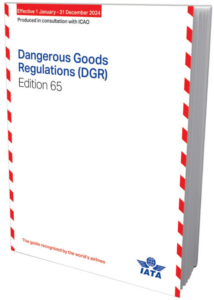
IATA Dangerous Goods Regulations Edition 65 (2024) Book
IATA DGR Edition 65 (2024). Recognized by airlines worldwide, the IATA Dangerous Goods Regulations (DGR) is the industry standard for shipping dangerous goods by air. It is the most complete, up-to-date and user-friendly reference manual trusted by the industry for over 60 years.
Maintaining compliance with the latest regulations is critical for safely shipping dangerous goods by air. The DGR draws from the industry’s most trustworthy cargo sources to help you classify, pack, mark, label and document shipments of dangerous goods. The DGR includes international dangerous goods air regulations, as well as state and airline requirements. It is an invaluable resource in ensuring you have all the information you need to ship safely and in compliance, at your fingertips.
The IATA Dangerous Goods Regulations manual is:
Available in other languages, contact Currie Associates for pricing and availability – [email protected] or call 518-761-0668
IATA DGR Edition 65 Significant Changes
Buy Now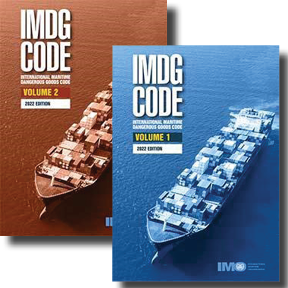
IMDG Code Amendment 41-22 Book Set (Vol. I & II)
The International Maritime Dangerous Goods (IMDG) Code is the mandatory framework for all aspects of handling dangerous goods and marine pollutants in sea transport. The provisions of the Code affect a whole range of industries and services such as manufacturers, packers, shippers, feeder services such as road and rail. the IMDG Code contains authoritative advice on classification, stowage, segregation, packing, labeling, terminology and emergency response action. This version of the Code, which incorporates amendment 41-22, is authorized for use 1 January 2023.
Amendment 41-22 (authorized for use 1 January 2023 / mandatory 1 January 2024).
IMDG Code Amendment 41-22 e-Reader
This e-reader is accessed using The IMO Bookshelf. Amendment 41-22 includes revisions to various sections of the Code and to transport requirements for specific substances. It is mandatory as from 1 January 2024 but may be applied by Administrations in whole or in part on a voluntary basis from 1 January 2023.
Volume 1 (parts 1, 2, 4, 5, 6 and 7) contains:
– general provisions, definitions and training
– classification
– packing and tank provisions
– consignment procedures
– construction and testing of packagings, IBCs, large packagings, portable tanks, MEGCs and road tank vehicles
– transport operations.
Volume 2 contains:
– part 3 (Dangerous Goods List, special provisions and exceptions)
– Appendix A (list of generic and N.O.S. proper shipping names) and Appendix B (glossary of terms)
– Index.
Refunds or exchanges not available on digital products.
Buy Now
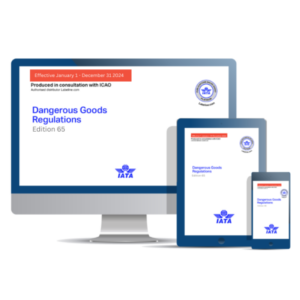
IATA Edition 65 (2024) Digital Version
This IATA publication is made available via a Bookshelf Online solution which is accessed through a browser. The publication can also be accessed offline using the Bookshelf software application, installed on a computer or tablet. When you get your first IATA Digital publication you’ll create a Bookshelf account to use both online and as a download (each licence comes with one download for a PC and one for a Mobile device).
Recognized by airlines worldwide, the IATA Dangerous Goods Regulations (DGR) is the industry standard for shipping dangerous goods by air. It is the most complete, up-to-date and user-friendly reference manual trusted by the industry for over 60 years.
Maintaining compliance with the latest regulations is critical for safely shipping dangerous goods by air. The DGR draws from the industry’s most trustworthy cargo sources to help you classify, pack, mark, label and document shipments of dangerous goods. The DGR includes international dangerous goods air regulations, as well as state and airline requirements. It is an invaluable resource in ensuring you have all the information you need to ship safely and in compliance, at your fingertips.
The IATA Dangerous Goods Regulations is:
You will receive your access link along with your log-in credentials within approximately 48 hours of your purchase during regular weekday business hours (9am – 5pm ET). Each user must have a valid email address in order to receive their credentials, one user per license.
Changes in the IATA DGR Edition 65 come into effect on 1st January 2024.
Refunds or exchanges not available on digital products.
IATA DGR Edition 65 Significant Changes
Buy Now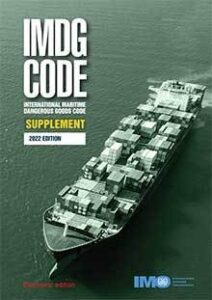
Supplement to the IMDG Code Amendment 41-22 Book
The International Maritime Dangerous Goods Code relates to the safe carriage of dangerous goods by sea, but does not include all details of procedures for packing of dangerous goods or actions to take in the event of an emergency or accident involving personnel who handle goods at sea. These aspects are covered by the publications that are associated with the IMDG Code, which are included in this Supplement.
The Supplement includes texts of the EmS Guide: Revised Emergency Response Procedures for Ships Carrying Dangerous Goods, the Medical First Aid Guide, descriptions of the reporting procedures for incidents involving dangerous goods, harmful substances and/or marine pollutants, the International Code for the Safe Carriage of Packaged Irradiated Nuclear Fuel, Plutonium and High-Level Radioactive Wastes on board Ships and other appropriate Assembly resolutions, resolutions and circulars of the Maritime Safety Committee and circulars of the Facilitation Committee and of the Sub-Committee on Dangerous Goods, Solid Cargoes and Containers.
Supplement to the IMDG Code Amendment 41-22 e-Reader
This e-reader is accessed using The IMO Bookshelf.
The International Maritime Dangerous Goods Code relates to the safe carriage of dangerous goods by sea, but does not include all details of procedures for packing of dangerous goods or actions to take in the event of an emergency or accident involving personnel who handle goods at sea. These aspects are covered by the publications that are associated with the IMDG Code, which are included in this Supplement.
The Supplement includes texts of the EmS Guide: Revised Emergency Response Procedures for Ships Carrying Dangerous Goods, the Medical First Aid Guide, descriptions of the reporting procedures for incidents involving dangerous goods, harmful substances and/or marine pollutants, the International Code for the Safe Carriage of Packaged Irradiated Nuclear Fuel, Plutonium and High-Level Radioactive Wastes on board Ships and other appropriate Assembly resolutions, resolutions and circulars of the Maritime Safety Committee and circulars of the Facilitation Committee and of the Sub-Committee on Dangerous Goods, Solid Cargoes and Containers.
Refunds or exchanges not available on digital products.
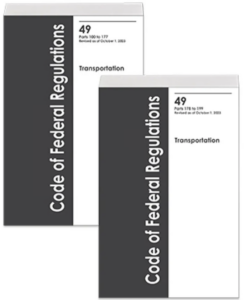
49 CFR Government Edition (Spring 2024 Edition)
Government 49 CFR DOT, 2-vol set, Parts 100-177 and Parts 178-199. Hazardous materials regulations including requirements for markings, labels, placards, shipping papers, training, emergency response and performance-oriented packaging standards are found in parts 100-177 in volume 1 and parts 178-199 in volume 2. Domestic transportation regulations for highway, rail, air and water are included. These regulations are a must if you handle hazardous material or hazardous waste, or if you a shipper, carrier or freight forwarder. Parts 186-199 specify pipeline regulations.
The Government 49 CFR 2-vol set comes in standard and spiral bound formats.
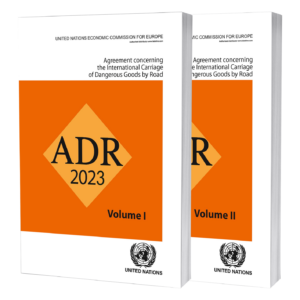
ADR – Agreement Concerning the International Carriage of Dangerous Goods by Road: Restructured ADR Applicable as from January 1, 2023
This publication presents the European Agreement, the Protocol Signatures, annexes and amendments for the transportation of dangerous goods. The various substances are listed and defined, as well as general and special provisions applicable to the transport of these dangerous materials.
2-Volume Set, Applicable as of January 1, 2023
The Agreement Concerning the International Carriage of Dangerous Goods by Road (ADR) includes:
This version has been prepared on the basis of amendments applicable as from 1 January 2023.
PRE-ORDER | Early Edition 49 CFR (October 2024) (expected availability Fall 2024)
Stay up-to-date on the most current regulatory updates with the Early 49 CFR. This is released about six months prior to the release of the government 49 CFR, with this version serving as an update to Parts 100-185. Featuring the same format as the government release, this standard edition is designed with a user-friendly layout that makes it easier to find information. This publication revision date is October 1, 2024.
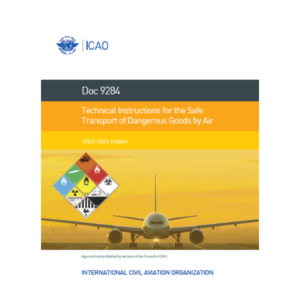
ICAO – Technical Instructions for the Safe Transport of Dangerous Goods by Air, 2023-2024 Edition
ICAO Technical Instructions for Safe Transport of Dangerous Goods by Air is for air freight shipments. ICAO’s Technical Instructions have been amended to align them more closely with the latest revised edition of the United Nations Recommendations on the Transport of Dangerous Goods. This edition incorporates all changes resulting from the amendments.
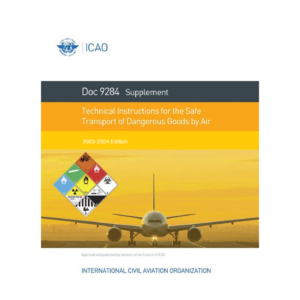
Supplement to the ICAO, 2023-2024 Edition
Supplement to the Technical Instructions for the Safe Transport of Dangerous Goods by Air, 2023-2024 Edition
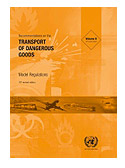
UN Orange Book – 23rd Edition (2023)
Recommendations on the Transport of Dangerous Goods, also known as the UN Orange Book, is the basis for the development of the international regulations concerning the transport of dangerous goods as well as most national legislations. This publication covers all modes of transport: road, sea and air.
These recommendations have been developed in the light of technical progress, the advent of new substances and materials, the exigencies of modern transport systems and above all, the requirement to ensure the safety of people, property and the environment. They are addressed to governments and international organisations concerned with the regulation of the transport of dangerous goods. The Model Regulations cover the classification of dangerous goods, their listing, the use, construction, testing and approval of packagings and portable tanks, as well as consignment procedures such as marking, labeling, placarding and documentation.
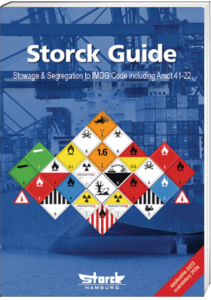
The Storck Guide: Stowage and Segregation references to the 41st Amendment to the IMDG Code. The Storck Guide: Stowage and Segregation lists cargo hazards in a color-coded table showing segregation from other classes. This publication summarizes general precautions for each class and lists special substances indexed by UN Numbers. The Storck Guide: Stowage and Segregation to the IMDC Code provides essential information for anyone involved in maritime transport of dangerous goods.